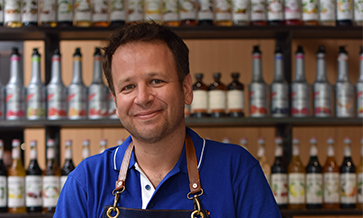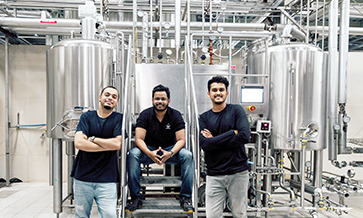Islay, among Scotland’s five whisky-making regions, is a magical island where much of its population is involved in whisky production. It is famous for its fiery, heavily peated whiskies. Vikram Achanta reports on a recent pilgrimage (with tastings) to its most iconic distilleries…
My first visit to Islay (pronounced ‘Eye-luh’) was in 2007, but I didn’t do justice to this home to some of the most iconic distilleries the world has ever seen. Back then, the smallest plane I’d ever flown in touched down at an airport surrounded by fields of sheep and peat bogs.
A bus whisked us away across the island to Port Askaig, from where we took a ferry to the Isle of Jura, home to another fabulous distillery and our main destination on that trip.
We could only look on like children in a sweet shop as the road flashed by signs directing us to these names: Ardbeg, Laphroaig, Lagavulin, and more. I promised myself I’d be back, but I didn’t know it would take 17 years to do so.
This time around we took the bus up from Glasgow though, a beautiful ride winding its way for a large part via the banks of Loch Lomond. A ferry from Port Kennacraig took us through to Port Ellen on Islay, and it was late at night when we reached our hotel, the lovely little Bowmore Inn.
The final stretch along the coast to Port Ellen is when the first of the three distilleries I named earlier appear. Port Ellen itself has a brand-new distillery, reopened in 2024 after its closure in 1983. Its owner, Diageo, also owns the massive Port Ellen Maltings, which operates 24x7, and its smokestack is visible from afar.
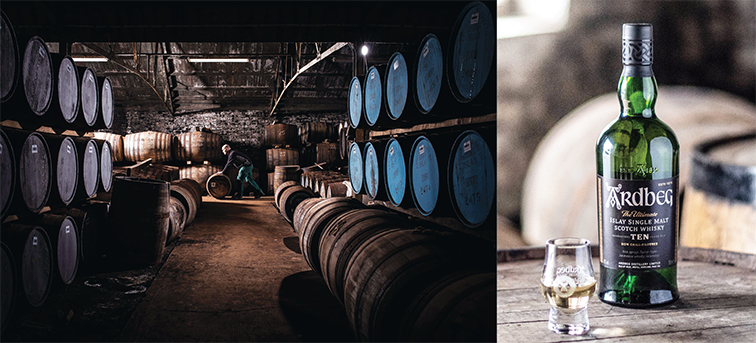
The growing demand for its tipples has seen a doubling of Ardbeg’s stillhouse capacity to 2.4 million litres a year (L). There is a burgeoning demand in China and India for the Ardbeg.
Islay festival
Islay is a whisky pilgrimage that draws lovers of its smoky whiskies from all parts of the world, testified by the array of languages we heard while on the ferry. Coincidentally, my trip is also well timed with the Feis Ile (pronounced ‘feish eel’). It’s the second biggest whisky-oriented festival in Scotland after the Speyside Festival.
In the last week of May, the island comes alive with each distillery celebrating its distillery day, welcoming the public at large with bars, food and music – always music! Each distillery also must put out a special festival edition release, a small batch whisky that is highly priced and is much coveted by collectors.
Islay’s distilleries have seen a remarkable rebirth over the last couple of decades. Till the ’80s, apart from a few hard-core whisky connoisseurs, whiskies from Islay were typically used to give a smoky element to blended Scotch.
When the market for blends imploded in the ’80s, it hit the distilleries on Islay hard, with some shutting down. The subsequent growth of single malt Scotch whisky as a category led to a remarkable revival in the distilleries on Islay, one of the five main regions of single malt production – the others are Speyside, the Highlands, Campbeltown and the Lowlands.
‘Driver drams’
Although fascinated by the thought of distillery tripping as I drove around the island, I had no wish to be intoxicated from all the whisky I’d drink at the distilleries. Fortunately, I discovered, there was a solution in the form of “driver drams” – a small measure is given to you to taste at each distillery, and the rest topped up in a miniature that is ceremoniously presented as you leave.
Although it’s a small island, the distilleries are in all corners, and the slots that we have booked for our tours result is in long drives, often rushed as we go from one distillery to the other.
On our first stop at Ardbeg, it’s an overcast day, and we make good use of our time by walking around the distillery, which is located by the sea and offers itself to picture-perfect photos.
Ardbeg closed in 1981 but re-opened in 1987 to satisfy a small demand from the blends. In 1997 it was purchased by the Glenmorangie Company. In 2005 the Glenmorangie was purchased by the luxury LVMH group, ensuring a stable financial foundation for the distillery.
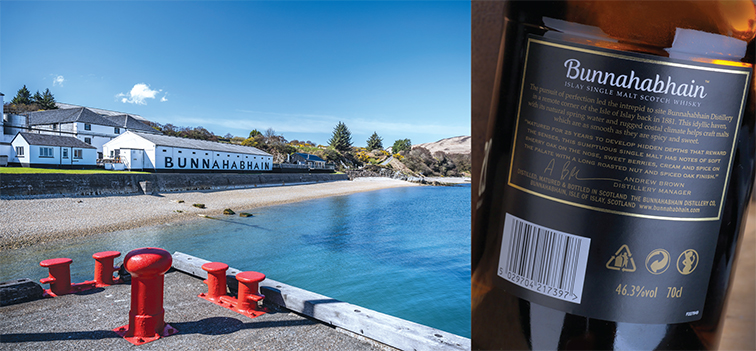
The Bunnahabhain distillery (L) has by far the most stunning of locations, looking out to the Isle of Jura. Bunnahabhain’s signature style is its unpeated single malt (R), helped by its source of pure spring water.
Ardbeg ardour
The burgeoning demand for its tipples has seen a doubling of its stillhouse capacity in 2021, from two to four stills, expanding capacity to 2.4 million litres a year.
Our tour starts with a sip of the extremely distinctive new-make spirit in the stillhouse before heading to Warehouse 3 for a tasting of something rich and old.
It’s worth noting that in 2022, a 1975 Ardbeg Cask (Cask No. 3) was sold for a world record Pounds16 million. Our guide for the tour, clearly a seasoned hand, pointed to exploding demand in China and India for the Ardbeg.
After we taste three delicious single-cask whiskies, drawn straight from the cask, our guide takes us on a short tour of the warehouse itself, pointing out a range of different types of casks.
Their philosophy as whisky makers is to be “marriers, not finishers”, focusing less on what is now an increasing trend in the whisky industry to keep the whisky for a short time before bottling it in casks that have previously held either beer, wine or another spirit like rum or Cognac.
Biggest distillery
Caol Ila is the biggest distillery on Islay, producing upwards of 6 million litres a year. These volumes are also linked to the fact that Caol Ila (pronounced Cull EE-lah, meaning the Sound of Islay in Scots Gaelic) is a large contributor to the Johnnie Walker Black Label blend, thus making it also the Islay home of Johnnie Walker.
The Spirit of Smoke is also a single cask experience, and there are five casks lined up behind out our hostess, Sarah. Given that there are so few of us, Sarah offers us the singular honour of drawing the whisky from the cask itself! The ABV (alcohol by volume) varies between 50% and 55% and I’m glad I’ve got the ‘Driver drams’ to take away.
We taste a range including a 17-YO virgin American oak (55% ABV), a 14-YO ex-Muscatel (54.4% ABV), a 13-YO first-fill ex-Bourbon (55.5% ABV), a refill cask (56.2% ABV) and a 20-YO unpeated (50.2% ABV) expressions.
The couple next to me are ardent whisky lovers, The woman is poetic about the whiskies she’s tasting, with each evoking specific memories for her and telling their story. It’s a rare pleasure to be with whisky lovers in an environment like this, with the liquid meaning so much more than just a name on the bottle.
I carry away my set of miniatures and the Glencairn glass that comes with it, expectant for a fresh set of experiences the next day.
At Laphroaig
The smoky whiskies of Islay owe much to the peat bogs that cover the island. Peat is a vegetable matter that has been quite literally vegetating for thousands of years. The peat is cut from peat banks, dried, and then used as fuel to smoke the barley in a kiln.
This gives the barley that distinctive smoky flavour that then carries on through to the whisky. The peat bogs used for Laphroaig are located quite near the airport. We’re in for a rare treat with the Wood Exploration Experience, which takes us from barley to bottle.
Laphroaig is one of the two distilleries on Islay that still use the traditional floor malting process, where the malt is spread out on the floor and then turned by a machine, as opposed to large drums typically used in this process. The other is Kilchoman that we’re scheduled to visit the next day.
Around 15% of Laphroaig’s barley is malted this way, with a large part of it used for special editions of the whisky. The distillery still has an operational kiln to peat its barley.
Our tour included tasting of three single cask specials: an ex-Maker’s Mark cask whisky aged for 7 years (53.3% ABV), a 7-YO virgin French oak (52.7% ABV) and a 6-YO aged in fino-sherry casks. My favourite is the one aged in the virgin French oak, which is a heavily charred cask, leading to a rich and dark-looking liquid carrying on through to the palate.
‘India’ on Islay
We decided to make good use of some spare time to visit a special place that marks the India flag on Islay. Sukhinder Singh and his brother Rajbir Singh, co-founders of The Whisky Exchange, are setting up Portintruan (pronounced port-nah-truan), a greenfield distillery on Islay, close to Port Ellen.
Having sold this massive drinks retail business to Pernod Ricard a few years ago, the brothers have set up Elixir Distillers.
On a recent visit to India, Sukhinder had told me about his plans for the distillery, and how it would be one of the most complex distilleries set up with its ability to make a range of styles of whiskies under one roof, quite akin to what some of the Japanese distilleries do.
My interest was piqued, and Sukhinder was gracious enough to organise an on-site visit with Georgie Crawford, his distillery manager and an industry veteran, who previously helped set up the Port Ellen distillery.
The greenfield distillery is under construction and is indeed massive, with lovely views out to the sea. Georgie walks us through via maps, the plans for the distillery, which indeed has much to promise and look forward to.
Bunnahabhain treat
We have a long haul to Bunnahabhain (pronounced ‘Bunn-na-ha-venn’, meaning ‘mouth of the river’ in Scots Gaelic). Of all the distilleries that I visited on Islay, this had by far the most stunning of locations, on a headland overlooking the Sound of Islay and looking out to the Isle of Jura.
Coincidentally, that day was also the day of the Jura Fell race, one of the toughest challenges in Scotland, a 16-mile run including seven mountain summits, with the three Paps (breasts) peaks included.
Bunnahabhain had a treat for us with their signature Warehouse 9 experience, anchored by Scotch whisky legend David Brodie. David takes us for a whistle-stop tour of the distillery before we move to Warehouse 9.
Like the others, this is a single-cask experience, with four 25-ml drams from the cask. Dan is quite a treat joy as the host – and delightfully politically incorrect in his script as he talks about the other distilleries on the island!
The whiskies ranged from the Muscat wine cask finish to a 2011 release of a Cognac cask finish. Bunnahabhain’s signature style is an unpeated single malt, helped by its source of pure spring water, which travels directly by pipes to the distillery without being touched by the abundance of peat on the island.
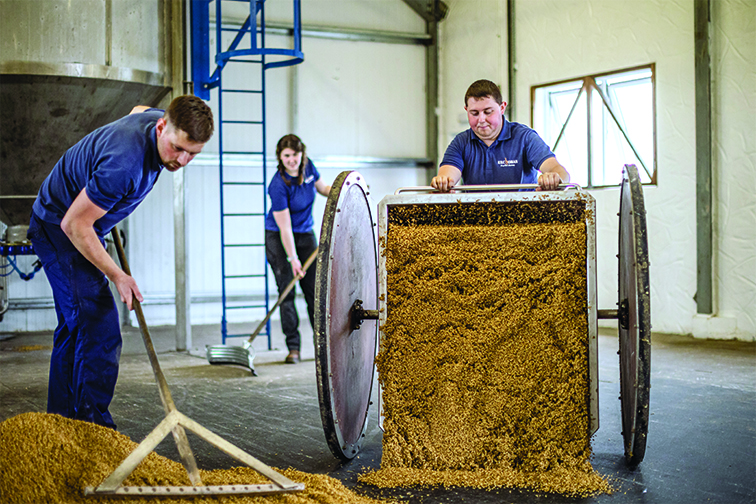
Kilchoman is a farm-to-bottle distillery where 20% of the barley it uses is grown on the farms surrounding the distillery. A portion of the barley is also floor malted.
Newcomer & legend
On the way back we decided to stop at Ardnahoe, the 9th distillery to be set up on Islay, for a quick taste of their first release, a 5-YO that has been matured in a combination of ex-Bourbon and ex-Oloroso sherry casks.
Ardnahoe was founded by the Laing family, who have rich experience as independent blenders and bottlers of Scotch whisky. The distillery is a tribute to the growing investment being made on Islay, both in the forms of rapid expansion of capacity across existing distilleries as well as new distilleries getting planning permission.
News broke while we are on Islay of Ian Mcleod Distillers setting up in Laggan Bay a new distillery in association with the Islay Boys, owners of Islay Ales, who make the local craft beer that I’ve been drinking.
Day 3 takes us to Lagavulin, another legend where, after a tour of the distillery, we taste the Lagavulin 8-YO, the distiller’s edition, and then finally the Feis Isle release of 2023.
Lagavulin is one of the oldest distilleries on the island, dating back more than 200 years. Its water source is the Lochan Sholum, situated 200 metres above sea level, and the water flows down the hillside through the peat. Its stills are unusually shaped, resembling pears.
Lagavulin is situated alongside the coast with Ardbeg and Laphroaig. There’s a very nice road, called the Three Distilleries Pathway, that starts just outside Port Ellen and connects all three distilleries.
On our drives back and forth the road over the 3 days, we see scores of people on the Pathway, quite a few of them with Glencairn glasses in their hand, sipping as they walked.
Farm, bottle, music
One of my favourite American sitcoms is one called Parks and Recreation, featuring the iconic character of Ron Swanson, played by the American actor Nick Offerman, whose love for Lagavulin is on full display during the series.
Lagavulin subsequently tied up with him for a series of special releases, with the latest and the 4th, finished in a Caribbean rum cask. Being a fan both of Nick and Lagavulin, I gladly pick up a bottle!
We journey to Kilchoman, a farm-to-bottle distillery where 20% of the barley it uses is grown on the farms surrounding the distillery. A portion of the barley is also floor malted.
I had the rare pleasure of meeting the founder, Anthony Wills, at the Vault Festival in Mumbai in 2019, and took advantage of the connection for a tasting h of half a dozen of their lovely expressions. I also picked up a bottle of the Loch Gorm, the distillery’s annual sherry-matured limited edition.
Back from Lagavulin, we rush to the Rock’ndaal music festival on Bruichladdich’s Day of the Islay festival. The distillery is alive with action, with scores of bars and food stalls set up across the grounds. I partake of a dram of the Octomore 8-YO.
Bruichladich’s signature expressions are unpeated, but they make up for it and more via their two other brands, Port Charlotte and Octomore, which are both heavily peated.
There are more than 2,000 people gathered around the grounds and, as I sip my Octomore, Tide Lines, the band that is headlining the festival, comes on stage to a raucous welcome. The music is rousing and upbeat, and it’s a fitting end to the marvellous 3 days spent on this magical island.
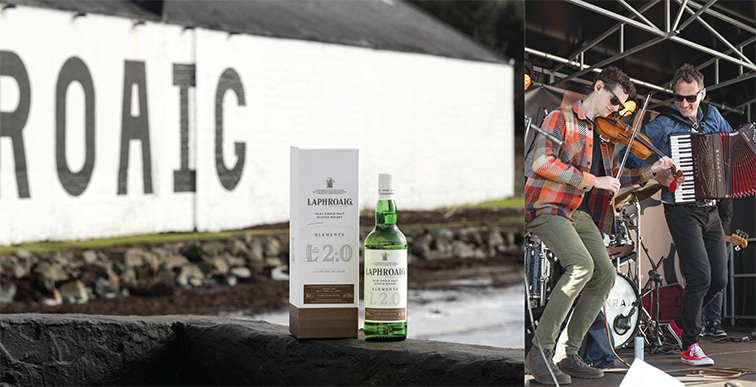
The smoky whiskies of Laphroaig (L) owe much to the peat bogs that cover the island. The Rock’ndaal music festival (R) on Bruichladdich’s Day of the Islay festival was alive with action, with more than 2,000 people gathered on the distillery’s grounds.












